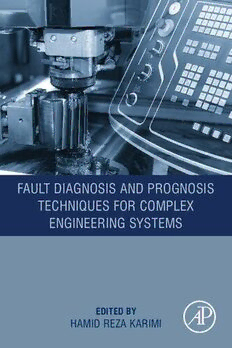
Fault Diagnosis and Prognosis Techniques for Complex Engineering Systems PDF
Preview Fault Diagnosis and Prognosis Techniques for Complex Engineering Systems
152 x 229 mm, Paper, PG, Spine: 20.828 mm FAULT DIAGNOSIS AND PROGNOSIS TECHNIQUES FF OA FOR COMPLEX ENGINEERING SYSTEMS RU L CT EDITED BY HAMID REZA KARIMI O D MI A Fault Diagnosis and Prognosis Techniques for Complex Engineering Systems gives a systematically and almost P G self-contained description of the many facets of envisaging, designing, implementing, or experimentally exploring L N emerging trends in fault diagnosis and failure prognosis in mechanical, electrical, hydraulic, and marine systems. E O X S The book is devoted to the development of mathematical methodologies for fault diagnosis and isolation, fault- E I tolerant control, and failure prognosis problems of engineering systems. It presents new techniques in reliability NS modeling, reliability analysis, reliability design, fault and failure detection, signal processing, and fault-tolerant control G A of engineering systems. INN ED It is specifically focusing on the development of mathematical methodologies for diagnosis and prognosis of faults E P or failures, providing a unified platform for understanding and applicability of advanced diagnosis and prognosis RR I methodologies for improving reliability purposes in both theory and practice, such as vehicles, manufacturing NO systems, circuits, flights, and marine systems. GG N S This book will be a valuable resource for different groups of readers—mechanical engineers working on vehicle YO systems, electrical engineers working on rotary machinery systems, control engineers working on fault detection SS systems, mathematicians and physician working on complex dynamics, and postgraduate students majoring in TI S mechatronics, control engineering, mechanical engineering, and applied mathematics. It can be also of significant E MT interest to the researchers within the mechatronics engineering society, including both academic and industrial parts. E S C Key Features H FAULT DIAGNOSIS AND PROGNOSIS • Presents recent advances of theory, technological aspects, and applications of advanced diagnosis and N prognosis methodologies in engineering applications. I Q TECHNIQUES FOR COMPLEX • Provides a series of latest results in, including but not limited to, fault detection, isolation, fault-tolerant U control, and failure prognosis of components. E • Gives numerical and simulation results in each chapter to reflect the S ENGINEERING SYSTEMS engineering practice, yet demonstrate the focus of the developed analysis and synthesis approaches. About the Editor Dr. Hamid Reza Karimi is a Professor of Applied Mechanics with the Department of Mechanical Engineering, Politecnico di Milano, Milan, Italy. His current research interests include control systems and mechatronics with applications to automotive systems, robotics, vibration systems, and wind energy. Prof. Karimi is currently the Editor- K in-Chief, Technical Editor, or Associate Editor for some international journals. He has been awarded as the 2016-2020 A Web of Science Highly Cited Researcher in Engineering and also received the 2020 IEEE Transactions on Circuits and R Systems Guillemin-Cauer Best Paper Award. IM I Technology and Engineering ISBN 978-0-12-822473-1 EDITED BY HAMID REZA KARIMI 9 780128 224731 Fault Diagnosis and Prognosis Techniques for Complex Engineering Systems Fault Diagnosis and Prognosis Techniques for Complex Engineering Systems Edited by Hamid Reza Karimi DepartmentofMechanicalEngineering,PolitecnicodiMilano,Italy AcademicPressisanimprintofElsevier 125LondonWall,LondonEC2Y5AS,UnitedKingdom 525BStreet,Suite1650,SanDiego,CA92101,UnitedStates 50HampshireStreet,5thFloor,Cambridge,MA02139,UnitedStates TheBoulevard,LangfordLane,Kidlington,OxfordOX51GB,UnitedKingdom Copyright©2021ElsevierInc.Allrightsreserved. Nopartofthispublicationmaybereproducedortransmittedinanyformorbyany means,electronicormechanical,includingphotocopying,recording,oranyinformation storageandretrievalsystem,withoutpermissioninwritingfromthepublisher.Details onhowtoseekpermission,furtherinformationaboutthePublisher’spermissions policiesandourarrangementswithorganizationssuchastheCopyrightClearance CenterandtheCopyrightLicensingAgency,canbefoundatourwebsite: www.elsevier.com/permissions. Thisbookandtheindividualcontributionscontainedinitareprotectedundercopyright bythePublisher(otherthanasmaybenotedherein). Notices Knowledge and best practice in this field are constantly changing. As new research and experience broaden our understanding, changes in research methods, professional practices,ormedicaltreatmentmaybecomenecessary. Practitionersandresearchersmustalwaysrelyontheirownexperienceandknowledgein evaluating and using any information, methods, compounds, or experiments described herein. In using such information or methods they should be mindful of their own safety and the safety of others, including parties for whom they have a professional responsibility. To the fullest extent of the law, neither the Publisher nor the authors, contributors, or editors, assume any liability for any injury and/or damage to persons or property as a matterofproductsliability,negligenceorotherwise,orfromanyuseoroperationofany methods,products,instructions,orideascontainedinthematerialherein. BritishLibraryCataloguing-in-PublicationData AcataloguerecordforthisbookisavailablefromtheBritishLibrary LibraryofCongressCataloging-in-PublicationData AcatalogrecordforthisbookisavailablefromtheLibraryofCongress ISBN:978-0-12-822473-1 For Information on all Academic Press publications visit our websiteathttps://www.elsevier.com/books-and-journals Publisher:MaraConner AcquisitionsEditor:SonniniR.Yura EditorialProjectManager:MeganHealy ProductionProjectManager:KameshRamajogi CoverDesigner:GregHarris TypesetbyAptara,NewDelhi,India Contents Contributors ix Preface xi 1 Quality-relatedfaultdetectionanddiagnosis:atechnical reviewandsummary GuangWangandHamidRezaKarimi 1.1 Introduction 1 1.2 Basicmethodology 6 1.3 Recentresearch 9 1.4 Simulation 27 AppendixA:Descriptionofthevariablesandfaults 43 References 47 2 Canonicalcorrelationanalysis–basedfaultdiagnosis methodfordynamicprocesses ZhiwenChenandKetianLiang 2.1 Introduction 51 2.2 Preliminaries 53 2.3 CCA-basedfaultdiagnosismethodfordynamic processes 63 2.4 Experimentalresultsandanalysis 71 2.5 Conclusion 82 Acknowledgments 84 References 84 3 H∞ Faultestimationforlineardiscretetime-varyingsystems withrandomuncertainties YueyangLi 3.1 Introduction 89 3.2 RobustH∞faultdetectionforLDTVsystemswith multiplicativenoise 91 3.3 RobustH∞faultdetectionforLDTVsystemswith measurementpacketloss 102 3.4 Fixed-lagH∞faultestimatordesignforLDTVsystems underanunreliablecommunicationlink 111 v vi Contents 3.5 Conclusion 123 Acknowledgments 123 References 123 4 Faultdiagnosisandfailureprognosisofelectricaldrives EliasG.Strangas 4.1 Introduction 127 4.2 Whatcanfailandhow 132 4.3 Diagnosismethodologyandtools 144 4.4 Faults,theirmanifestation,anddiagnosis 150 4.5 Failureprognosis,faultmitigation,andreliability 165 References 175 5 Intelligentfaultdiagnosisfordynamicsystemsviaextended stateobserverandsoftcomputing PaulP.Lin 5.1 Introduction 182 5.2 Extendedstateobserver 183 5.3 Casestudy:three-tankdynamicsystem 188 5.4 FaultdetectionbymeansofESO 192 5.5 Faultisolationandfaultidentification 194 5.6 Simultaneousfaultsofdifferenttypes 197 5.7 Isolationofsimultaneousprocessfaultsandactuatorfaults 200 5.8 Conclusionandfuturework 203 References 204 6 Faultdiagnosisandfailureprognosisinhydraulicsystems JieLiu,YanheXu,KaiboZhouandMing-FengGe 6.1 Applicationstatusofsensordetectiontechnology 207 6.2 Cavitationresearch 217 6.3 Intelligentevaluationanddiagnosistechnology 229 6.4 Prognosticsresearch 244 References 253 7 Faultdetectionandfaultidentificationinmarinecurrent turbines TianzhenWang,ZhichaoLiandYilaiZheng 7.1 TheHT-baseddetectionmethod 264 7.2 Thewaveletthresholddenoising–baseddectectionmethod 269 7.3 Theidentificationmethodofbladeattachmentbasedon thesparseautoencoderandsoftmaxregression 283 7.4 Theidentificationmethodofbladeattachmentbased ondepthwiseseparableCNN 290 Contents vii 7.5 Conclusionandfutureworks 299 References 300 8 Quadrotoractuatorfaultdiagnosisandaccommodation basedonnonlinearadaptivestateobserver SichengZhou,KexinGuo,XiangYu,LeiGuoandYouminZhang 8.1 Introduction 305 8.2 Mathematicalmodelofaquadrotor 307 8.3 NASO-basedFTC 309 8.4 Validation 319 8.5 Conclusion 323 References 323 9 Defectdetectionandclassificationinweldingusingdeep learninganddigitalradiography M-Mahdi Naddaf-Sh, Sadra Naddaf-Sh, Hassan Zargaradeh, Sayyed M. Zahiri,MaximDalton,GabrielElpersandAmirR.Kashani 9.1 Introduction 327 9.2 Literaturereview 333 9.3 Databasepreparation 336 9.4 Experimentalstudy 336 9.5 Experimentalimplementation 345 9.6 Conclusion 346 References 347 10 Real-timefaultdiagnosisusingdeepfusionoffeatures extractedbyPeLSTMandCNN FunaZhou,ZhiqiangZhangandDanminChen 10.1 Introduction 353 10.2 Basictheory 356 10.3 DeepfusionoffeatureextractedbyPeLSTMandCNN 357 10.4 Experimentaltesting 371 10.5 Conclusionandfuturework 395 Acknowledgment 398 References 398 Index 401 Contributors DanminChen,SchoolofSoftware,HenanUniversity,China ZhiwenChen,SchoolofAutomation,CentralSouthUniversity,China Maxim Dalton, Artificial Intelligence Lab, Stanley Oil, and Gas, Stanley Black, and Decker,UnitedStates Gabriel Elpers, Artificial Intelligence Lab, Stanley Oil, and Gas, Stanley Black, and Decker,UnitedStates Ming-Feng Ge, School of Mechanical Engineering and Electronic Information, China UniversityofGeosciences,China KexinGuo,SchoolofAutomationScienceandElectricalEngineering,BeihangUniver- sity,China LeiGuo,SchoolofAutomationScienceandElectricalEngineering,BeihangUniversity; Beijing Advanced Innovation Center for BigData-Based Precision Medicine, Bei- hangUniversity,Beijing,China HamidReza Karimi, Department of Mechanical Engineering, Politecnico di Milano, Italy AmirR.Kashani,ArtificialIntelligenceLab,StanleyOil,andGas,StanleyBlack,and Decker,UnitedStates YueyangLi,SchoolofElectricalEngineering,UniversityofJinan,China ZhichaoLi,SchoolofLogisticEngineering,ShanghaiMaritimeUniversity,China KetianLiang,SchoolofAutomation,CentralSouthUniversity,China PaulP.Lin,FellowoftheAmericanSocietyofMechanicalEngineers(ASME);Professor Emeritus,MechanicalEngineeringDepartment,ClevelandStateUniversity,United States;VisitingScholar,KaohsiungUniversityofScienceandTechnology,Taiwan M-Mahdi Naddaf-Sh, Electrical Engineering Department, Lamar University, United States SadraNaddaf-Sh,ElectricalEngineeringDepartment,LamarUniversity,UnitedStates EliasG.Strangas,MichiganStateUniversity,UnitedStates GuangWang,NorthChinaElectricPowerUniversity–BaodingCampus,China TianzhenWang,SchoolofLogisticEngineering,ShanghaiMaritimeUniversity,China XiangYu,SchoolofAutomationScienceandElectricalEngineering,BeihangUniver- sity;Beijing Advanced Innovation Center for BigData-Based Precision Medicine, BeihangUniversity,Beijing,China ix
